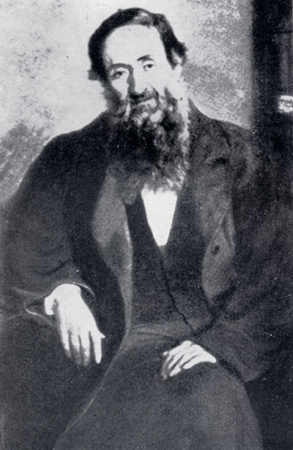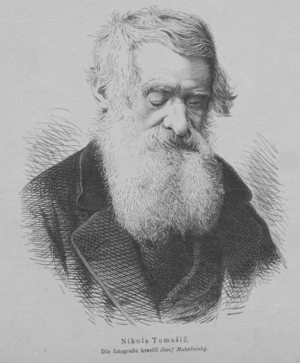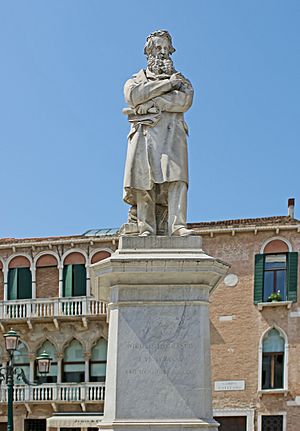Niccolò Tommaseo facts for kids
Niccolò Tommaseo (born October 9, 1802 – died May 1, 1874) was an important writer, language expert, and journalist from Dalmatia. He created a huge eight-volume Dictionary of the Italian Language. He also wrote a dictionary of similar words (synonyms) and many other books. People see him as someone who helped start the idea of Italian irredentism, which was about uniting all Italian-speaking lands with Italy.
Contents
Niccolò Tommaseo's Life Story
Niccolò Tommaseo was born in a town called Sebenico (now Šibenik). This town was ruled by different groups over time, including the Venetians, the French under Napoleon, and the Austrians. Even though he grew up in a changing world, Tommaseo felt very connected to Italian culture. He also showed a real interest in the local culture of the Illyrian people. He studied in Spalato (now Split), where he received a strong education focused on classic subjects and Catholic teachings.
Moving to Italy and Becoming a Journalist
In 1822, Tommaseo moved to Italy to study law at the University of Padua. After finishing his studies, he spent several years working as a journalist. He traveled between Padua and Milan, where he met famous writers like Alessandro Manzoni. During this time, he began writing for a well-known journal called Antologia. This journal was part of an important intellectual center in Florence. He also wrote letters to other important figures, including Petar II Petrović Njegoš from Montenegro. Some experts believe Niccolò Tommaseo's writings are important to both Italian and Serbian literature.
Life in Florence and Paris
In 1827, Tommaseo moved to Florence. He quickly became a key writer for the Antologia journal. In 1830, his book New Dictionary of Synonyms of the Italian Language was published, which made him very famous. However, he had to leave Italy and go to Paris. This happened after he wrote an article supporting the Greek revolution, which upset the Austrian government and led to his journal being shut down.
While living in Paris, he wrote several important books. These included a political work called About Italy (1835) and a book of poems. He also wrote a historical novel and a detailed commentary on Dante Alighieri's famous Divine Comedy.
Travels and Later Works
From Paris, Tommaseo traveled to Corsica, an island known for its rich oral traditions. With help from a local judge, he collected many Italian folk songs and stories from the island. He believed he found the purest Italian dialect there.
Later, in Venice, he published parts of his novel Faith and Beauty. This book is now seen as an early example of a psychological novel, which explores the inner thoughts and feelings of characters. He also put together an anthology of popular songs from Italy, Corsica, Illyria, and Greece. These works showed his interest in different cultures, going beyond simple nationalism.
Challenges and Final Years
In 1847, Tommaseo returned to journalism. He strongly supported the idea of a completely free press. Because of his strong views, he was arrested, which caused a stir. He was freed during a liberal revolution led by Daniele Manin. Tommaseo then took on responsibilities in the short-lived Venetian Republic. When Austrian control returned, he was sent into exile in Corfù because he was seen as supporting Italian unity.
In Corfù, his eyesight began to fail. Despite this, he continued to write many essays. In one essay, written in French, he argued that the Church should give up its worldly power in the Papal States. Around this time, he also stopped believing that the "moderate" path through the House of Savoy would lead to the Unification of Italy.
In 1854, with his sight getting worse, he moved to Turin. Then, in 1859, he moved back to Florence. He disagreed with the House of Savoy and refused any honors, including a seat in the Senate. In his final years, he dedicated himself to completing his large dictionary of the Italian language. This seven-volume work was finished in 1874, after his death.
Main Works
- New Dictionary of Synonyms of the Italian Language (1830)
- Popular Songs: Italian, Corsican, Illyrian, Greek (1841)
- The Letters of Saint Catherine of Siena (1860, 4 volumes)
- The Second Exile (1862, 3 volumes), a collection of his political writings
- On the Death Penalty (1865)
- New Studies on Dante (1865)
- Aesthetic Dictionary (new edition 1872)
- Moral Thoughts
See also
 In Spanish: Niccolò Tommaseo para niños
In Spanish: Niccolò Tommaseo para niños




